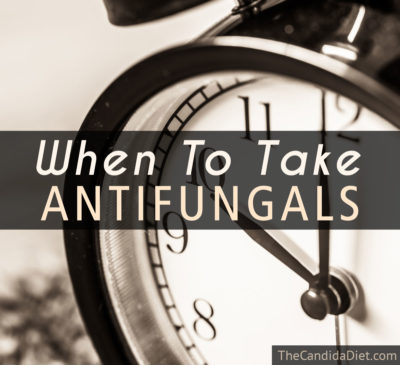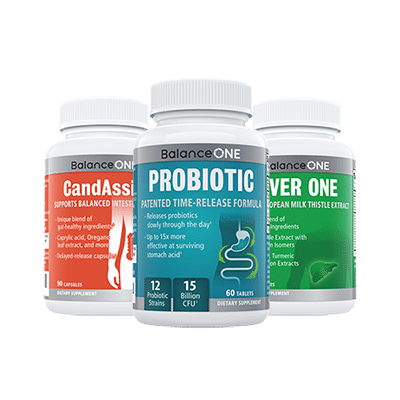When Should You Take Antifungals?

You can start your antifungals a few weeks after you begin your anti-Candida diet. As with probiotics, there are some good reasons to wait until you have finished the cleanse before you start your course of antifungals.
If you take antifungals while you are in the initial cleansing phase of the diet, they are liable to be quickly expelled from your system with all the pathogens, bacteria, and other matter that are washed through your digestive system. And you don’t want to put too much stress on your body by prompting Candida Die-Off when you have just begun the diet.
In our Candida program, we also recommend starting your antifungals a week or more after you begin taking probiotic supplements and foods. Probiotics and antifungals are both powerful elements of the Candida treatment plan, so it’s really important to leave enough time between starting each of these phases. The reason is that both probiotics and antifungals are liable to cause Candida Die-Off, so to start courses of both at the same time could potentially make for a very challenging start to your treatment.
Table Of Contents
Why You Need To Choose A Good Antifungal
Antifungals play an important part in the Candida Diet by destroying the cells of the Candida albicans yeast or fungus. The antifungals work with probiotics to first kill the Candida overgrowth, then repopulate your gut with healthy bacteria. Some antifungals (e.g. caprylic acid) can also help to restore your stomach to its correct acidity and restrain the growth and spread of the Candida colonies even further.
Candida can adapt to individual antifungals over time, so many dieters choose to take multiple antifungal supplements at the same time. Some good options are caprylic acid, garlic, grapefruit seed extract (GSE) and oil of oregano. Take a look at our choosing an antifungal page for more information.
Be aware that rotating your antifungals can lead to your particular strain of Candida building up resistance to individual antifungals. That’s why Dr Eric Wood and I recommend taking two or three antifungals at the same time to prevent this happening. Also remember to increase your dosage slowly, in order to avoid a severe Die-Off reaction.
A good way to do this is with our new CandAssist formula. It contains 7 natural antifungals and comes in a daily dose of three small capsules, so you can start with a single capsule and slowly increase your dose.
Can You Take Probiotics And Antifungals At The Same Time?
There is no good reason why you shouldn’t take probiotics and antifungals on the same day. Yes, it’s true that some antifungals have antibiotic properties, so they might kill a few of the beneficial bacteria that you are using to repopulate your stomach. However, if you think about it this is actually a reason to keep taking probiotics. If the antifungals are potentially reducing your healthy gut flora even further, reintroducing ‘good’ bacteria is exactly what your digestive system needs. This is very much the same argument as why you should take probiotics during a course of antibiotics.
To get the most benefit from both supplements, you should also try to take them at least 2 hours apart during the day. You can take your antifungals first and allow them to work on the Candida colonies in your gut, then take your probiotics a couple of hours later when the antifungals have dissipated.
Be aware of the many foods that have antifungal and antibiotic properties. These include garlic, coconut oil, and rutabaga (sometimes known as Swede).
As mentioned above, its important that you leave at least 1-2 weeks between starting your courses of probiotics and antifungals. This is to avoid a severe Die-Off reaction, and it will help you to complete the diet with less discomfort.
Will You Always Need To Take Antifungals?
You should stop taking your antifungals after you have completed your treatment plan and you feel that you have beaten your Candida overgrowth. This is where antifungals differ from probiotics. There are very good reasons for continuing to take probiotic supplements and foods indefinitely to maintain your balance of gut flora and the acidity in your digestive tract. Remember also that the yeast can adapt to many antifungals, so you may find that they begin lose their effectiveness over time anyway.
When you end your course of antifungals, I would recommend coming off the treatment slowly and monitoring your health carefully. If you feel that you are regressing and your Candida overgrowth is starting to resume, return to your original dosage until you feel comfortable again. If you cut the dosage and you feel fine, then feel free to keep reducing your intake of antifungals until you have quit the supplements altogether. As always, consult your doctor about your antifungal treatment if you have any concerns.
CandAssist
Wouldn’t it be great if there was one product that contained the most powerful natural antifungals?
Well, now there is! I worked with Balance One Supplements to develop CandAssist. It contains natural antifungals including Caprylic Acid, Undecylenic Acid, Oregano Leaf Extract, Berberine HCl, Betaine HCl, Olive Leaf Extract, and Garlic Extract.
CandAssist uses the highest-quality natural ingredients. It’s vegan, non-GMO, and made in the USA. You can read more about it here.
For lots more information on how to choose the right antifungals for your treatment, as well as the 28 best antifungal foods to include in your diet, take a look at our Ultimate Candida Diet treatment program.

3-Month Candida Elimination Kit Start Your 3-month Candida Cleanse
This Candida Kit contains all the supplements recommended on the Candida Diet:
- LIVER ONE to process and remove the toxins created by Candida.
- CANDASSIST to inhibit and weaken the Candida colonies in your gut.
- PROBIOTIC to replace the Candida yeast with probiotic bacteria.
Plus... the CANDIDA DIET RECIPE BOOK with 50+ low-sugar recipes

Leave a Reply